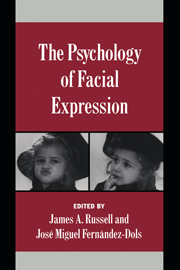Book contents
- Frontmatter
- Contents
- Foreword
- Preface
- Contributors
- Part I Introduction
- 1 What does a facial expression mean?
- 2 Methods for the study of facial behavior
- Part II Three broad theoretical frameworks
- Part III With a biological and developmental focus
- Part IV With a psychological and social focus
- Part V Integrative summary
- Author index
- Subject index
- Studies in Emotion and Social Interaction
2 - Methods for the study of facial behavior
Published online by Cambridge University Press: 11 March 2010
- Frontmatter
- Contents
- Foreword
- Preface
- Contributors
- Part I Introduction
- 1 What does a facial expression mean?
- 2 Methods for the study of facial behavior
- Part II Three broad theoretical frameworks
- Part III With a biological and developmental focus
- Part IV With a psychological and social focus
- Part V Integrative summary
- Author index
- Subject index
- Studies in Emotion and Social Interaction
Summary
In the present chapter, I first survey the main methods that have been applied to the study of faces and indicate how different methods relate to different types of research questions. I make no claim that this survey is complete; space would not permit this. In particular, I do not consider ethological approaches (see Eibl-Eibesfeldt, 1989, especially chapters 2 and 6). Following this brief survey, I focus on judgment studies and examine the components of such studies in some detail, reexamining the assumptions underlying the usual practices in the application of judgment methods and their analysis. It will become apparent that these usual practices, while mostly appropriate for addressing certain questions about facial behavior, lack generalizability to many other important questions.
Ways of studying facial behavior
The range of questions that may be asked about facial behavior is apparent from the other chapters of this volume. A consideration of these questions suggests that they may be differentiated from one another on the basis of which of two general aims the study of the face has. An examination of the methods available indicates that they are not equally applicable to questions with different general aims. Many questions involve describing or measuring facial behavior. Such questions include: What can facial behavior tell us about the number and nature of distinct emotions? (That is, are there “basic,” or “fundamental,” emotions?) How is facial behavior involved in the experience of emotions? Does facial behavior directly reflect emotional experience? Are there individual differences (and gender differences) in facial behavior? Essentially, these questions do not involve any consideration of what is communicated by facial behavior or how it is interpreted by others.
- Type
- Chapter
- Information
- The Psychology of Facial Expression , pp. 31 - 54Publisher: Cambridge University PressPrint publication year: 1997
- 18
- Cited by

